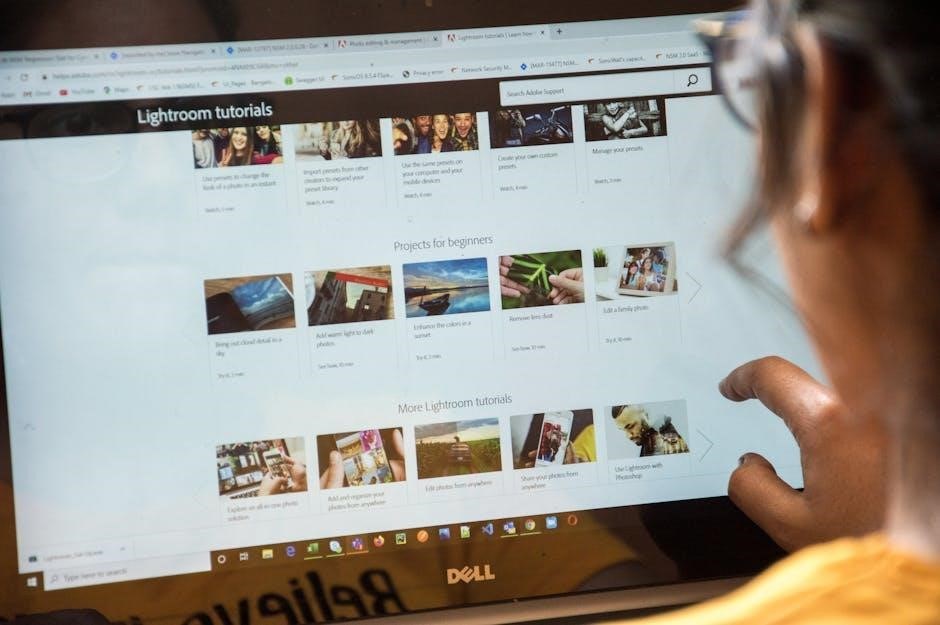Navigating internet resources requires understanding online tools and techniques‚ using hyperlinks and search engines to access specific websites and web pages quickly and efficiently every day always online.
Understanding URLs and Internet Addresses
A URL is the exact address of a resource on the internet‚ such as a webpage‚ image‚ or file‚ and is typically typed into a web browser’s address bar to navigate directly to a specific resource. The URL provides the specific location of a resource‚ guiding the user to the desired webpage or file; For instance‚ https://example.com/about is a URL that points to the About page of a website. Understanding URLs and internet addresses is essential for navigating internet resources efficiently. URLs can be used to access specific resources‚ such as webpages‚ images‚ or files‚ and can be shared with others to provide direct access to a particular resource. By understanding how URLs work‚ users can navigate the internet more effectively and access the resources they need quickly and easily using online tools and techniques. This is a fundamental skill for navigating internet resources.

Navigational Tools and Techniques
Using hyperlinks and search engines to access websites and web pages quickly and efficiently every day always online is very important for navigation purposes only.
Using URLs to Access Specific Resources
Understanding how to use URLs to access specific resources is crucial for navigating the internet. A URL‚ or Uniform Resource Locator‚ is the address of a specific resource on the internet‚ such as a webpage‚ image‚ or file. By typing a URL into a web browser’s address bar‚ users can directly access the desired resource. For example‚ typing https://example.com/about into a web browser’s address bar will take the user directly to the About page of the example.com website. This allows users to quickly and easily access the information they need‚ without having to navigate through multiple web pages. URLs can be used to access a wide range of resources‚ including websites‚ web pages‚ images‚ videos‚ and more. By using URLs‚ users can efficiently navigate the internet and access the information they need. This is an essential skill for anyone looking to navigate the internet effectively.
Understanding Top-Level Domains
Top-level domains are an essential part of navigating the internet‚ as they help users identify the type of website or resource they are accessing. Top-level domains are the last part of a URL‚ such as .com‚ .org‚ or .edu‚ and they provide information about the website’s purpose or location. For example‚ .com is typically used for commercial websites‚ while .org is used for non-profit organizations. Understanding top-level domains can help users quickly identify the type of website they are visiting and make informed decisions about the credibility and reliability of the information they find. By recognizing top-level domains‚ users can also avoid accessing websites that may be malicious or untrustworthy. Overall‚ understanding top-level domains is an important skill for anyone looking to navigate the internet safely and effectively‚ and it can help users make the most of their online experience. This knowledge is essential for internet users.

Searching and Browsing Internet Resources
Searching and browsing internet resources involves using search engines and directories to find specific information and websites online quickly every day.
Types of Navigational Tools Available
There are various types of navigational tools available to help users navigate internet resources‚ including search engines‚ directories‚ and hyperlinks. These tools enable users to quickly and easily find specific information and websites online.
Search engines use algorithms to index and retrieve web pages‚ while directories rely on human editors to organize and categorize websites;
Hyperlinks allow users to navigate between web pages and websites by clicking on links. Additionally‚ other navigational tools such as bookmarks‚ history‚ and browser extensions are also available to enhance the browsing experience.
These tools simplify the process of navigating internet resources‚ making it easier for users to find what they need; Overall‚ the variety of navigational tools available provides users with flexibility and convenience when exploring the internet. With these tools‚ users can efficiently navigate and discover new online resources. They are essential for internet navigation.

Library Standards and Consistency
Library standards ensure consistency in cataloging and classification systems for easy resource location always online every day.
Importance of Consistent Formats for Library Records
Consistent formats for library records are crucial for efficient navigation and access to information. The use of standardized metadata and cataloging systems enables users to quickly locate specific resources. Library records are organized in a way that makes it easy to search and retrieve information‚ saving time and effort. Consistency in formatting also helps to prevent errors and inconsistencies‚ ensuring that users can rely on the accuracy of the information. Furthermore‚ consistent formats facilitate the sharing and exchange of library records between different institutions and systems‚ promoting collaboration and resource sharing. By using standardized formats‚ libraries can provide better services to their users and improve the overall navigation and accessibility of their resources. This is especially important in today’s digital age‚ where users expect to be able to access information quickly and easily.

Basic Computer Navigation and Internet Guide
Learning computer basics and internet navigation skills using online resources and tutorials effectively every day.
Learning Different Navigation Techniques for Computer Use
Navigation techniques for computer use involve understanding various methods to access and utilize online resources. Using menus and toolbars can help users navigate through websites and web pages efficiently. Additionally‚ learning keyboard shortcuts can save time and improve productivity. Online tutorials and guides provide step-by-step instructions on how to use these navigation techniques. By mastering these skills‚ users can effectively browse and search the internet‚ access specific resources‚ and manage their online activities. Furthermore‚ understanding how to use bookmarking and history features can help users keep track of their favorite websites and previously visited pages. Overall‚ learning different navigation techniques is essential for effective computer use and internet navigation. With practice and experience‚ users can become proficient in using these techniques to achieve their online goals.
